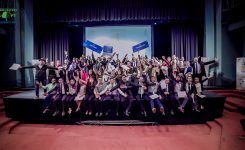Design Thinking
From Insights to Innovation: Inside the Design Thinking Process
In a world where the most challenges are complex and inherently human, design thinking becomes a survival skill.
At ERGO, we recognize that the path to innovation often lies in exploring the unknown and navigating through ambiguity. Our design thinking framework is crafted to help us move confidently through these ambiguous spaces, using each phase to build upon the insights and learnings of the previous one. This structured yet flexible approach allows us to uncover new possibilities and craft solutions that are innovative, grounded in user needs, and tailored to real-world contexts. At ERGO, our design thinking framework consists of four interconnected and iterative phases: Discovery, Inspiration, Design, and Growth.
Phase 1: Discovery
The Discovery phase lays the foundation for the entire process, inviting us to engage with challenges from a fresh, unbiased perspective. This phase is characterized by conscious discovery- intentionally setting aside preconceived notions, biases and past experiences to fully immerse ourselves in the problem space. By taking a systems approach and examining the challenge from multiple angles, we identify knowledge gaps and gather missing information, allowing us to explore the problem with clarity.
Some of the key tools and methods we use during Discovery include:
- Challenge Mapping: Breaking down complex problems into their core components.
- Stakeholder Mapping: Identifying the key players involved and their roles.
- System Mapping: Visualizing the interconnected elements and relationships within a system to see how different factors influence one another.
This phase helps us untangle complexity, revealing new insights, trends, and design opportunities that would otherwise remain hidden.
Phase 2: Inspiration
In the Inspiration phase, our focus is on truly understanding the user—both their practical needs and deeper emotional drivers. By immersing ourselves in their environment, we gain firsthand insights into their experiences, and gain a clearer understanding of their perspective. We use a mixed methods approach to we uncover valuable insights into what shapes their behaviors and choices.
Key techniques in this phase include:
- Ethnographic Research: Observing users in context to understand their needs, choices, pain points, and behaviors.
- Empathy Mapping: Capturing what users think, feel, say, and do to paint a holistic picture of their tensions and motivations.
- Contextual Immersion: Fully immersing in the user’s environment and experiences to gain a deeper understanding of their world and perspective.
- Insight Finding: Identifying key patterns and observations that reveal deeper user needs and opportunities.
- Point of View: Framing the challenge from the user’s perspective to guide meaningful solutions.
The insights we gather during Inspiration are not just about identifying obvious needs—they help us uncover underlying emotions and motivations. We then reframe these insights into design opportunities that go beyond surface-level solutions.
Phase 3: Design
The Design phase is where creativity and strategy come together. With the insights from the Inspiration phase in hand, we generate a broad range of solutions through ideation. This phase is all about exploring possibilities, testing ideas, and iterating quickly based on user testing.
The key methodologies we employ in this phase include:
- Divergent Thinking: Encouraging wide-ranging ideas without judgment, allowing for exploration of all potential solutions.
- Prototyping: Building tangible representations of ideas to test concepts early and often.
- User Testing: Gathering real-world feedback from users to refine and improve prototypes.
The iterative Build-Measure-Learn cycle is critical here, allowing us to continuously fine-tune ideas until we arrive at a solution that’s both innovative and user-centered. The end goal is to create a prototype that resonates with users while aligning with business goals.
Phase 4: Growth
The Growth phase is all about turning tested prototypes into fully developed products or services. Here, we concentrate on scaling the solution and integrating it into a sustainable business model. The goal isn’t just to launch a new product or service—it’s to create a foundation for lasting success.
Key activities in this phase include:
- Business Model Design: Mapping out how the solution will create, deliver, and capture value.
- Market Analysis: Understanding the competitive landscape to identify opportunities for differentiation.
- Customer Journey Mapping: Mapping out how users will interact with the solution post-launch, ensuring a seamless and valuable experience.
- Growth Hacking: Focusing on rapid experimentation across marketing channels to find the most effective ways to grow the business.
- Innovation Blueprinting: Creating a comprehensive plan that outlines the scope, roles, resources, and action steps required to bring the solution to market.
As we progress through the Growth phase, our attention moves beyond launch to ensuring the solution can thrive in a dynamic market. With scalability and adaptability built in, the innovation is prepared to evolve alongside customer needs and market shifts.
The Iterative Nature of Design Thinking
One of the most powerful aspects of design thinking is its iterative nature. It’s not a linear process; it’s cyclical and user-driven, which means we continually revisit each phase as new insights emerge. This flexibility allows us to adapt and refine solutions to meet evolving user needs and market dynamics. At every step, the user remains at the center of our process, ensuring that the innovations we deliver are both meaningful and future-relevant.
By embracing design thinking, organizations can break through conventional barriers, delivering user-centered innovations that solve today’s challenges while anticipating tomorrow’s needs.
Are you ready to unlock the power of design thinking in your organization?
Get in Touch to discover how this human-centered approach can lead to breakthrough innovation and long-lasting success.






